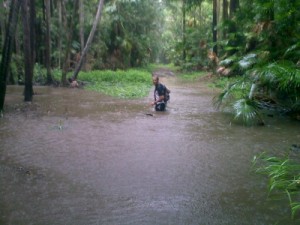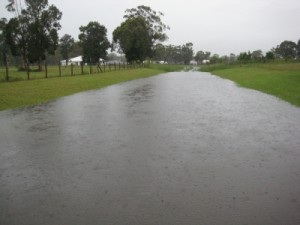Here in Northern California, I keep hearing complaints about the weather. I’m guilty of bellyaching about the rain, cold, and mucky trails, too. Note to self: Quit whining. Imagine living in rain-ravaged Queensland, Australia, where rising waters recently cut off more than 20 towns, displaced tens of thousands of people, and flooded an area about the size of France and Germany combined. Would you keep your commitment to run if you lived in those conditions?
(Update: 24 hours after I first published this post, Brisbane—Australia’s third-largest city—was hit by the worst flash flooding yet this season. Thousands of people had to evacuate, dozens are missing, and at least nine died in the raging waters. I don’t mean to make light of the situation with the light tone of this article below. Use common sense and don’t run through deep water, as the guest author describes, unless you’re absolutely certain you won’t be swept away. The situation in Queensland is heartbreaking—here’s a link to more info and an appeal for help.)

The flooding Down Under is far north of Sydney, but I couldn't resist this iconic image as seen through a rain-splattered ferry window last year. (Photo by Morgan C. Smith)
Ultrarunner Andy Bowen of Noosa, Queensland, is sticking with his training plan even if he has to build an ark to reach land to run on. I asked him if I could reprint his article below from his blog because he offers good advice for dealing with drenching conditions. I’m also impressed with this guy because he’s determined to run 1400K (868 miles) in September, in the scorching sun on a godforsaken straight road in Western Australia, all to raise money for two worthwhile charities for autism and sudden infant death syndrome. (Read more about his challenge.)

Andy says, "All in all it was a fun run, and although I wasn’t always outwardly smiling, the kid inside was having a ball!"
Here’s Andy’s perspective and advice:
Training for an Ultramarathon, Whatever the Weather!
The weather conditions in Queensland have been making headlines around the world, and even though I’m not in the area that badly affected, it has had an impact on my running. The thing with training for an ultramarathon is that you cannot allow the weather conditions to stop you from training. They won’t change the event date if you are ill prepared, and ultra courses are not known for being all the forgiving either!
So today, after three days of over 50mm [2 inches] of rain each, and another 180mm [7 inches] today, I scheduled a run. I waited until a lively thunderstorm passed and headed out in the rain.
Running in the rain can be an opportunity to be miserable and complain about the cold and wet, but as I was on my own with no one to listen to any complaints, I chose to embrace the conditions and release my inner child!
My shoes were wet before I started as they hadn’t dried out from my last outing, and this was a good thing, because I didn’t waste any effort on avoiding puddles. In the course of 33kms [20.5 miles], I had to wade through waist-deep water on four occasions.
For at least 10kms I was running on tracks which actually had water flowing along them (I always seemed to be running upstream!) and for the final few kms I had to put on the reflective vest as I had to run along the road itself as the foot path was impassable. That last section was pretty scary in parts as there was a raging torrent on either side of the road, as well as flowing across it, and I had to go through this at the same time as avoiding being run down by passing traffic.
All in all it was a fun run, and although I wasn’t always outwardly smiling, the kid inside was having a ball! But I did learn a few things that are worth keeping in mind when running in the wet.
1. Wear a hat – Running in the rain without one is just plain uncomfortable. The rain can be stinging in your eyes, and you’ll be running with your eyes scrunched up without one.
2. Wear as little as possible – Whatever you wear will become soaked, and that means a lot more weight you have to carry around. This is especially important with regards to shoes as the effective weight is amplified because it is carried on the ends of your legs (unless you wear your shoes somewhere else of course!). I’d say that my shoes were carrying an extra third of a kilo (about half a pound) each, and that’s a lot of extra effort when you’re out for four hours. I also had my hydration backpack which was just like a sponge, and no matter how much I drank it didn’t seem to get any lighter.
3. Tape and grease those chaffing zones – I tape my nipples to avoid blood stains on my shirt (!) and today the tape washed off (I’ve run for 33 hours in the dry without the tape even coming loose before). Also because of the wet clothing, I suffered some nasty chaffing on my lower back and armpits from my pack. I’d normally get mild redness, but with the wet clothing clinging to my skin and rubbing I now have patches of raw skin. These create the most painful experience in ultrarunning when you shower off after a run and wash salt from sweat and then soap into open wounds. Ouch!
4. Keep your kit dry – I have a couple of waterproof liner bags which I use inside my pack to keep all my kit dry. This is essential for your phone, but also very nice to have a change of clothing or medical kit which would be useless when soaked. I actually keep all my race gear in my pack all the time, as it is good preparation, and it really paid off today as I would not have been happy or even safe without my reflective vest (I hadn’t planned on being out in the dark before I set off).
5. Embrace the conditions and have FUN – Just accept that you are going to get wet, and to make the most of it. There were many times today when running was more like canyoning, having to cope with water half way up my shins flowing along the tracks, and it was great fun.
6. Concentrate – With the water on the tracks, they are a lot more slippery (especially tree roots). Worse still, you can’t see where your foot will be landing as the water is too deep. You need to be prepared for the unexpected, as regularly today I thought I was stepping in water a few inches deep, but actually was up to my knees. On the downstream(!) sections it was incredibly difficult to control speed, and I was running with eyes the size of plates, such was the need to appreciate where I was putting my feet and what the surface beneath them would be like.
7. Run straight – If your feet are soaked anyway, why dart from side to side to avoid a little more water? This not only uses more energy, but with slippery ground any lateral moment can end up in a fall (and potential injury). What I have also discovered is that with a forefoot/midfoot strike beneath your hips you slip far less and have more control, as there is less lateral or forward momentum in your foot as it makes contact with the ground.
Thanks, Andy, for sharing this piece!
Postscript:
I googled “running in the rain” to come up with a few photos to complement Andy’s snapshots above. The search produced an eclectic collection that included this, which I quite like:
Then I scrolled down and saw this next shot. Hey, wait, that looks familiar. What’s that shot of me from 2009 doing near the shot of F-Winter? It’s amazing what Google Images turns up.




Perfect timing. The rain just started falling and my resolve to run was falling with it. Time to suit up and hit the trail!